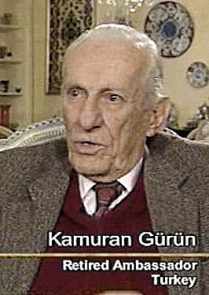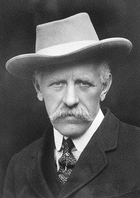|
|
The following excerpt
from "The Armenian File — The Myth of Innocence
Exposed" by Kamuran Gürün (pp. 215-219) sheds convincing
light on the number of Armenians killed during the time of the Armenian
"Genocide."
|
|
|
| |
General Bronsart [von Schellendorf], who was Chief of Staff to
the Ottoman Commander-in-Chief, wrote as follows in an article in the 24 July 1921 issue
of the newspaper Deutsche Allgemeine Zeitung:
As demonstrated by the innumerable declarations, provocative pamphlets, weapons,
ammunition, explosives, &c., found in areas inhabited by Armenians, the rebellion was
prepared for a long time, organized, strengthened and financed by Russia. Information was
received on time in Istanbul about an Armenian assassination attempt directed at high
ranking state officials and officers.
Since all the Muslims capable of bearing arms were in the Turkish Army, it was easy to
organize a terrible massacre by the Armenians against defenceless people, because the
Armenians were not only attacking the sides and rear of the Eastern Army paralysed at the
front by the Russians, but were attacking the Muslim folk in the region as well. The
Armenian atrocities which I have witnessed were far worse than the so called Turkish
brutality.
|
|
Let us quote
now a few statements from an anti-Turkish book. Hassan Arfa writes:
When the Russian armies invaded Turkey after the Sarikamish disaster of 1914, their
columns were preceded by battalions of irregular Armenian volunteers, both from the
Caucasus and from Turkey. One of these was commanded by a certain Andranik, a bloodthirsty
adventurer. These Armenian volunteers, in order to avenge their compatriots who had
been massacred by the Kurds, committed all kinds of excesses, more than six hundred
thousand Kurds being killed between 1915 and 1916 in the eastern vilayets of Turkey.
|
| |
 |
|
Kamuran
Gurun ("Sari Gelin") |
The Armenians were forced to
emigrate because they had joined the ranks of the enemy. The fact that they were civilians
does not change the situation. Those who were killed in Hiroshima and Nagasaki during the
Second World War were also civilians, Those who were killed during the First World War in
France, Belgium, and Holland were also civilians. Those who died in London during the
Battle of Britain were also civilians. We gave above some examples as to how the civilians
were killed. Turkey did not kill them, but relocated them. As it was impossible to adopt a
better solution under the circumstances, it cannot he accepted that those who died because
they were unable to resist the hardships of the journey were killed by the Turks.
Let us give a similar example.
During the struggle for independence, the French evacuated Marash. and 5,000 Armenians
left Marash with the French. The date was 10 February 1920. The journey lasted until 14
February. The result: 200 dead, among which 7 officers, and commander Marty; 300 wounded
were brought back; 11 wounded were abandoned in Marash; 150 evacuated had their legs
frozen; 2-3,000 Armenians died during the retreat.
Did the French massacre these Armenians?
There remain only those who were killed en route, defenceless. The
responsibility here lies with the Government because it was unable to protect these
individuals, or because officials winked at the killings. The Government arrested those
who were responsible for this, as far as it was able to determine the culprits, and sent
them to the martial law court. Quite a few of them were executed.
How many individuals lost their lives as they were killed defencelessly? Even at that time
it was not possible to determine this, and it is impossible to determine it today.
|
|
The statistics given as the
death toll today are invariably the total of the individuals who died for all
reasons we have stated above, from the declaration of war until the armistice. The
figure which is increased today to 2,000,000 is this total. In his blue book,
Toynbee wrote that the number of Armenians who died might be 600,000. He computed
this number by subtracting the number of Armenians who were alive after the
emigration from the Armenian population before the war. Today we are able to do this
computation more easily, by comparison with the existing documents.
 |
|
Fridtjof Nansen (1861-1930) |
Dr. Fridtjof
Nansen’s report states that, according to the League of Nations Emigrants’
Committee, the number of Armenians who emigrated during the First World War from
Turkey to Russia was between 400,000 and 420,000. This figure is the number of
Armenians who emigrated from Turkey, and who were living in Russia at the end of the
war. It is apparent that these emigrants went to Russia before the Moscow Treaty
with Russia, which was signed on 16 March 1921
In 1921, the Istanbul
Patriarch, in a statistic he gave to the British, showed the number of Armenians
living within the Ottoman borders before the Sèvres Agreement as 625,000, including
those who returned after they had emigrated. Including those who emigrated to
Russia, we reach the figure of 1,045,000.
As the Armenian population in Turkey in 1914 was approximately 1,300,000, the total
number of Armenians who died during the war cannot be more than 300,000.
|
| |
Another method of computation is possible. In
Toynbee’s computation in the document we have mentioned above (note No. 92), it is
stated that on 5 April 1916, in the regions of Zor, Aleppo, and Damascus, the number
of emigrants was 500,000. It is natural that this figure will have considerably
increased up to the end of 1916, because the process of emigration continued until
the end of 1916, and because all those who had been required to emigrate were not
sent only to these three regions.
We stated that the number of those who were required to emigrate was 702,900. Even
if the emigrants who were alive on 5 April 1916 were from these three regions, and
even if all those who emigrated after this date died, the number of those who died
during the emigration would be 200,000. Because it is impossible that the sum of
those who emigrated other than to the regions of Zor, Damascus, and Aleppo on 5
April 1916 and the sum of those who emigrated after this date could have died, it is
apparent that, based upon this computation, the number of those who died from all
causes was well below 100,000. And this would indicate that most of the casualties
occurred during armed confrontations outside the process of emigration.
|
|
ADDENDUM
(summer 2005)
Holdwater believes Gurun
was in error with the 702,900 figure, as Ara Sarafian had pointed out. As one can read
in the Census page, this likely represented the number of Turks who were (and here we
can use the word accurately) deported from Russian conquered Ottoman lands
(702,905.). The same Turkish source provides 924,158 as the number of Armenians who
were resettled.
Holdwater is also not
certain about the emigration policy continuing... for all practical purposes...
until the end of 1916, as Gurun states. If there were a continuance, the additional
numbers must have been insignificant. For example, Henry Morgenthau was quoted (by Vahan Cardashian, in a March 3, 1916 letter
to Lord Bryce) as saying Armenians were found in good numbers in almost all the
interior cities of Turkey, and that the attitude of the Government was passive.
(The Armenian Review, Winter 1957, p. 107.)
|
A third computation method would be based on the
population of the Republic of Turkey.
In the Turkish Republic the first census was held in 1927. At that time the Armenian
population of the country was 123,602.
In the 1931 census in France it was established that there were 29,227 foreigners, who
were born in various countries, 5,114 who were born in Turkey, but who were French
citizens. There were approximately 35,000 Armenians. It is obvious that all of them had
come from Turkey.
The Canadian records show that 1,244 Armenians had come from Turkey between 1912 and 1914
(Imre Ferenczi, International Migration, Vol. 1, New York, 1929, p. 891).
In the same period, 34,136 Armenians emigrated to the United States, all of them from
Turkey (Robert Mirak, Armenian Emigration to the U.S. to 1915).
In 1928, the number of Armenians
who emigrated to Greece was 42,200 (League of Nations A. 33-1927).
The Bulgarian statistics record that in 1920 there were 10,848, and in 1926, 25,402
Gregorian Armenians (Annuaire statistique du Royaume de Bulgarie, 1931, p. 35). It is
apparent that the difference of 15,000 Armenians came from Turkey.
Again according to the statistics of the League of Nations, 2,500 Armenians went to
Cyprus.
Hovannisian gives the number of Armenians who emigrated to the Arab countries and Iran in
the following list (‘The Ebb and Flow of the Armenian Minority in the Arab Middle East’,
Middle East Journal, Vol. 28, No. 1(Winter 1974), p. 20):
Syria 100,000
Lebanon 50,000
Jordan 10,000
Egypt 40,000
Iraq 25,000
Iran 50,000
When we add to these figures the 420,000 Armenians who emigrated to Russia, we reach
824,560, or 825,000 if we round it up. If we count those who went to other European
countries, the missing and the forgotten as 50,000, we reach the figure of 875,000. With
the population of 123,000 in Turkey, we obtain 998,000. When we subtract this number from
the Armenian population in Turkey in 1914 of 1,300,000, we obtain 302,000.
Therefore, every computation indicates that the number of casualties (we use this term
because this is a society at war) of the Armenians of Turkey, for all reasons, did not
exceed 300,000. It is obvious that among these casualties the number of deaths which
occurred for whatever reason during the emigration will be less than this figure, and the
number of those who can be considered as having been killed will be even less.
|
|
A murderer is a murderer, no excuse can be given.
Just as we do not condone the fact that the Armenians massacred the Turks, we do not
condone the fact that the Turks massacred the Armenians. However, the Armenians who
were massacred were not massacred on the orders of the Government. As we have stated
above, the culprits who were arrested were sent to the courts, were given sentences,
including the death sentence, and the sentences were carried out.
We would have wished that the Armenians who massacred the Turks had also been
punished. But, in Armenian books, they are portrayed as national heroes.
|
| |
|
|